|
Hahoe 10 Masks
Wooden
masks used in Hahoe Pyolshin-Gut T'al-nori (Hahoe Mask
Dance Drama) are made of the alder tree. They were first
made in the middle period of the Korea dynasty (c.12 C)
by Huh doryong. There were originally fourteen of these
treasured Masks. Three of these (Chongak [Bridegroom],
Byulchae and Ttuckdari-t'al) were lost. Eleven (Imae,
Ch'oraengi, Kakshi, Chuji, Paekchong, Halmi, Chung, Yangban,
Sonbi and Pune,) have been designated as National Treasure
(No. 121). The distinctive characteristics of the Hahoe
masks are of formative beauty. Fixed features of the Masks
convey the expressions of joyful and pleasant feelings,
and of the angry and grievous emotion. Thus, they are
recognized as prominent masterpieces throughout the world.
Especially the Masks of Yangban, Sonbi, Chung, and Paekchong.
They are constructed naturally. The mouths will open and
close. The movements of the chins in drama conversation
expose the feelings of the characters very well. It is
historically appreciated that Kakshi, Pune, and Halmi
Masks do not have nostrils. Their mouths are small and
reveal the social status and nature of the day.
|
|
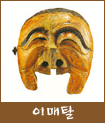
Imae: A Fool
|
As the legend goes, Imae T'al is the mask without a chin.
He plays the role of a foolish person and the servant
of the Sonbi. His figure is roughly distorted, but discloses
his naivete. His crooked nose reveals that one of his
four hands and legs is deformed. The downslanted eyes
signify that he is free from malice.
Dancing form: Imae's faltering steps.
|
|
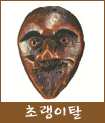
Ch'oraengi: The Hasty Scatterbrained
Meddler
|
The characteristics of Ch'oraengi are generally flippant
expressions of a slave of the Yangban. His twisted and
firmly closed mouth shows his discontented expression.
The protruded forehead means the stubborn figure who disagrees
with his master. His short nose represents his hasty actions.
Dancing form: Ch'oraengi's frivolous steps.
|
|
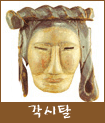
Kaksi : The Bride
|
Kakshi enters as a substitute of the local goddess. She
is generally quiet and calm, but her lips are firmly closed.
This expression connotes that she is trying to keep her
new marrage, and her tough life in her heart. She wears
long tresses of hair in front and back. These show she
only moves her head for hanging tresses when she is walking
Dancing form: Kakshi's soft steps.
|
|
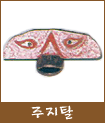
Chuji : The Lion
|
This mask is similar to wings or fins. Chuji means lion
in a Korean dialect. In another version of the mask dance,
Chuji is called a pheasant-fight.
Dancing
form: Chuji's fluttering steps.
|
|
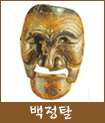
Paekchong : The Butcher
|
The generally ill-tempered nature of Paekchong T'al shows
a malicious figure with murderous intent when drooping
his head. When he leaning backwards he has an insane grin
because of his sense of guilt derived from killing bulls.
His crooked forehead signifies he is of a sinister and
cruel nature.
Dancing form: Paekchong's perverse
steps
|
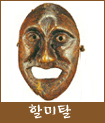
Halmi : The Old
Widow |
Enters Halmi, the extremely poor old widow due to her
hardship of life. The expressions around her eyes disclose
the elderly strength derived from a person who has tasted
the sweets and bitters of life. Her mouth shows the hungry
expression, and her upward peaked head means that her
later life is unfortunate.
Dancing form: Halmi's hip dance.
|
|
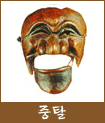
Chung : The Depraved
Buddhist Monk
|
He
is not a monk who trains himself at a Buddhist temple,
but a wandering and depraved monk whose grin is roughly
insidious. The crescent-shaped eyes accord with his characteristics
revealed in his lecherous behavior.
Dancing
form: Chung's deceitful steps.
|
|
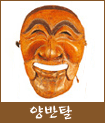
Yangban : The Aristocrat
|
Yangban T'al is viewed as the masterpiece best representing
the aesthetic value among Hahoe masks. Its expression
is generally gentle, mixed with bombastic and leisurely
expressions, just as goes the saying; "Yangban picks
his teeth, even when he drinks water". The separarte
chin with a hanging string makes firm the mouth when drooping
the head, and thus changes himself into an angry face.
Dancing form: Yangban's swaggering
steps.
|
|
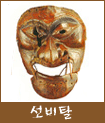
Sonbi : The Scholar
|
Sonbi's expression reveals his ever disgruntled state
not by adapting himself to common social structure. Additionally,
he shows his dignity as a scholar and his unscholarly
arrogance. The wide bridge around the tip of his nose
and the developed cheekbone fit the scholarly figure.
Dancing form: Sonbi's long strides.
|
|
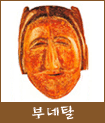
Pune : The Flirtatious
Young Woman
|
Pune's oval face, crescent-shaped eyebrows, high nose,
and small mouth are considered as the conditions of a
beauty in our conventional society. She enters as a concubine
and singing and dancing girl of Yangban and Sonbi. The
lewdness around the outer corners of her eyes and mouth
signifies that she is a wanton woman. The crescent-shaped
eyebrows mean that she is endowed with the artistic quality.
Dancing form: Pune's elegant steps.
|


